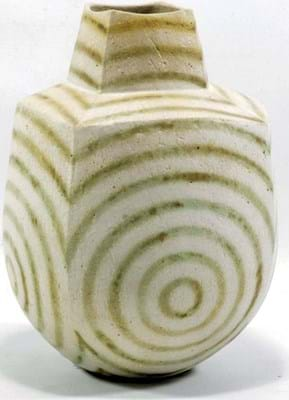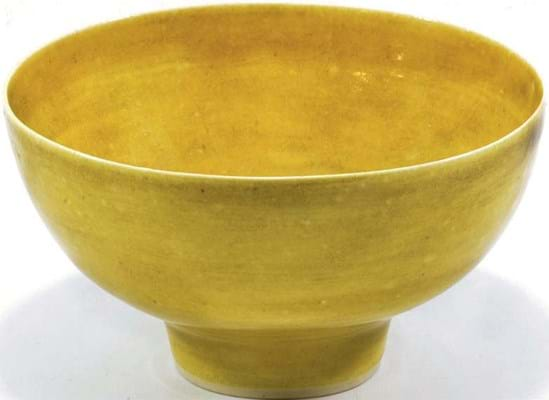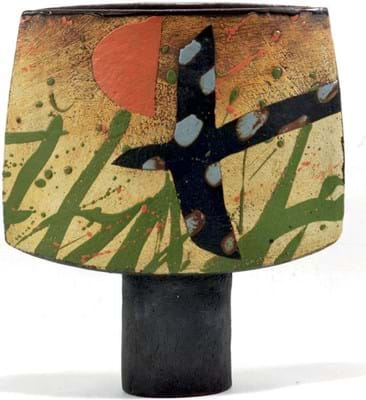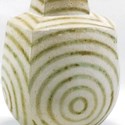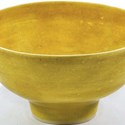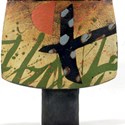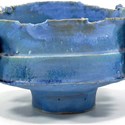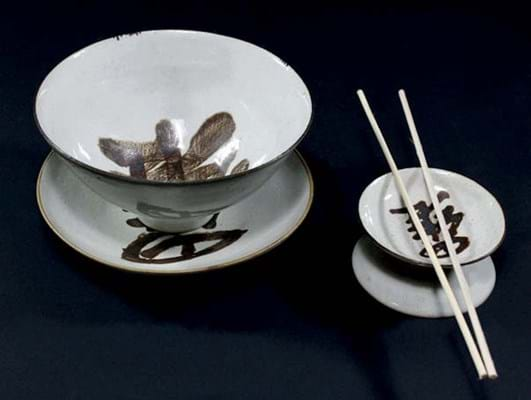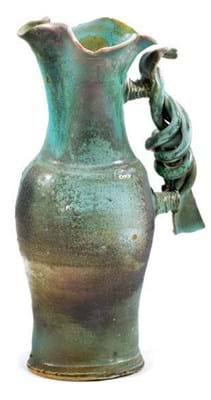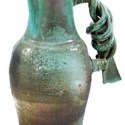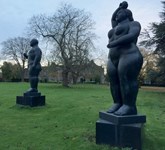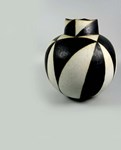Ultra-high prices for Dame Lucie Rie and her one-time apprentice Hans Coper have brought national publicity but at the core of the market have been auction house specialists.
They include experts such as Michael Jeffery at Woolley & Wallis and Philip Smith, previously of Mallams Oxford (soon to join Lyon & Turnbull), whose December sales were reported in ATG No 2324; Marijke Varrall-Jones at Maak in London and Jason Wood at Adam Partridge in Macclesfield.
Wood has put together studio ceramics sales at Adam Partridge (15% buyer’s premium) for the past four years – including the triumph of the Firth Collection in 2015 (ATG No 2214) – and catalogued the latest on March 16.
He has witnessed a steady rise in the market at every level, but even the superstars remain accessible to collectors prepared to accept restoration or minor faults.
Accessible studio pottery superstars
At this latest Macclesfield auction, Rie’s restored 7in (18cm) diameter porcelain footed bowl with mustard yellow glaze made a triple-estimate £3200. A one-off 1956 commission of a 5½in (14cm) diameter white stoneware Rijsttafel trio of rice bowl, stand and chopsticks with manganese calligraphic designs went below estimate at £1650.
Modern sculpted works have risen much more spectactularly than the thrown pottery in the tradition of Bernard Leach which remains affordable at most levels.
The Partridge sale included a number of stoneware pieces by Bernard’s son, David (1911-2005), which made the point.
Two were from the Lowerdown Pottery he established at Bovey Tracy: a pair of 5in (12.5cm) tall lobed vases going within estimate at £75 and a 9in (22.5cm) tall bottle with a willow tree motif more than doubling expectations at £480.
The frequent price gap for the same potter is one factor which makes studio ceramics such an attractive field for collectors, particularly those who refine their collections by shrewd selling and buying.
A couple of stoneware works with impressed marks by Colin Pearson (1923-2007), who took over management of the Aylesford Pottery from David Leach in 1956, were cases in point.
His 11in (28cm) tall jug with a twisted handle had some nibble and some loss to the semi-matt turquoise glaze and sold a shade above estimate at £340. The following lot, a 14in (35cm) wide oval open vessel with four textured wings covered in semi-matt blue/green glaze, had no discernible faults and doubled expectations at £2300.
Works by the in-demand ‘second generation’ potters sell at a similarly varied price range, demonstrated by two pieces by Ewen Henderson (1934-2000). He was a pupil of Rie and Coper and, like a number of the British potters, a former student at Camberwell College of Arts.
At Partridge’s sale his 12¾in (32.5cm) tall, tapered stoneware vessel with impressed decoration had repaired firing cracks and sold within estimate at £420.
By contrast, his 16in (40cm) tall bottle-form vase of mixed laminated stoneware and bone china clays appeared in faultless condition and, against a £400-600 estimate, sold at £3500.
Wide range
Wood, who regards his role more as a curator than cataloguer of these specialist sales, has a policy of offering material across a wide range of potters and prices – including new works by young ceramicists who, he says, get a better deal at auction than at galleries. “I try to get a cross-section of material which will appeal to different tastes,” he said.
With most bids coming from privates – sometimes represented by dealers – he sees buyers in three groups, very broadly.
There are the very rich collectors ready, for instance, to pay six figures for a trophy Coper piece (although Wood wonders if, having got everything they want for exhibitions in 2020, the centenary year of Coper’s birth, the market will cool down thereafter).
Then there is the broad swathe of collectors who can still enter the market at less than £100 and, with luck, trade up to names selling in high four-figures.
Finally, a new force is emerging, as decorators look for eye-catching statement pieces for clients’ homes – “much more effective and cheaper than flat art”, observes Wood.
He believes a broad swathe of subjects encourages people to turn up at the rooms to bid and occasionally be seduced by other material if their target item sells above their limits. “For example, one such bidder switched his interest to a stoneware bottle by Mike Dodd,” he said.
The 12½in (32cm) tall cut-sided vessel of red Devonshire clay with a high silica wood ash glaze was estimated at £120-180 but sold at £900. “That’s unheard of,” added Wood.
Three of the other four pieces with the MJD mark of Dodd (b.1943) sold at around their £80-180 estimates but, following the £900 surprise, a very similar Dodd vessel estimated at £100-150 sold at £660.
The still-developing market in 20th century ceramics, and its constant refreshment by newcomers (which, incidentally, means buyers paying the 4% Artist’s Resale Right), means buyers can indulge in the intriguing thought that their favourites may become hugely admired and, therefore, pricey.
They will reflect how this has happened to such names as John Ward (b.1938), John Maltby (b.1936), Emmanuel Cooper (1936-2012) and Gordon Baldwin (b.1932), all of whom were represented at Macclesfield.
Maltby, who was an apprentice at the Lowerdown Pottery in 1962 before setting up his own studio near Crediton, has been making good money for some time, particularly for his stoneware spade vases with stylised landscape decoration.
Three such vases with painted signature were sold at the Adam Partridge auction.
One, standing 7½in (19.5cm) tall with a small glaze flake, doubled the estimate at £620.
A second, 10½in (27cm) tall with professional restoration and a faint hairline crack, quadrupled estimate at £1650.
The third was 13in (33.5cm) tall with the landscape enhanced by a bird flying over reeds under a red sun. With no faults and an estimate of £500-700, it sold at £6200.
Best-seller of the three Cooper lots, all of which took above-estimate four-figure bids, was a conical 9½in (24cm) diameter porcelain bowl in a pale blue glaze with Venetian red and gold highlights.
Made in 2010, it was purchased at Cooper’s last selling exhibition in 2012 and at Macclesfield it doubled the top estimate in selling at £3600.
All six typical works by Gordon Baldwin got away at four-figure sums, with the best being a 2ft 2in (66cm) 2007 earthenware sculptural work titled Round a Square III, at an above-estimate £2400.
Going to Ward
The ever-rising stock of John Ward was witnessed with a near-record price in Cardiff last week (see separate Auction Reports online story this week), but probably as significant, given that it was not one of his hugely fashionable black and white vases, was another piece offered in Macclesfield.
It was a 10in (25.5cm) tall square stoneware bottle-form vase with mottled green geometric pattern on off-white ground. Estimated at £800-1200, it sold at £8800.
True to the theme that big names don’t have to mean big money, Ward’s 5in (13.5cm) tall, straightsided stoneware vessel with only minor nibbles to the ring could be had at £620.


